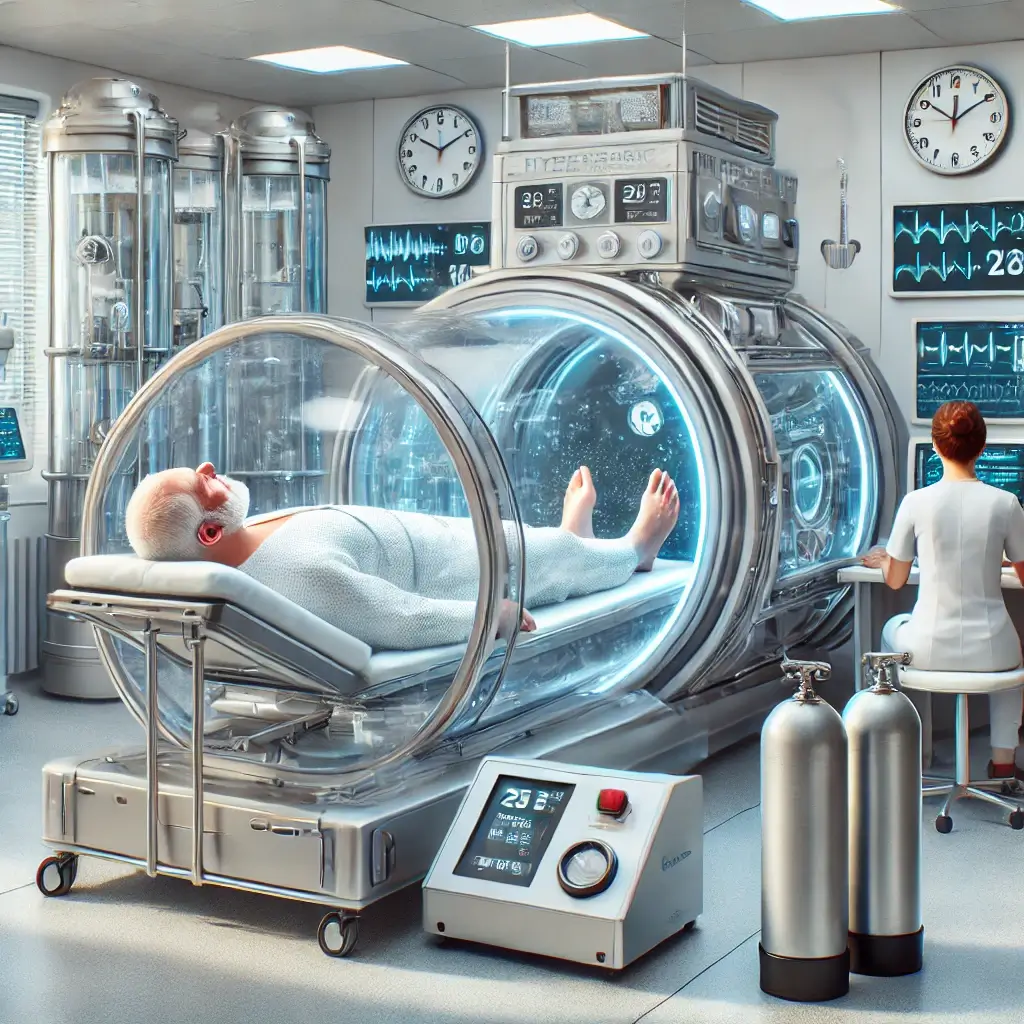Maximizing HBOT Benefits: Clinical Best Practices for Anti-Aging Practitioner
Introduction to HBOT in Anti-Aging Medicine
Hyperbaric Oxygen Therapy in anti-aging medicine has become a prominent tool in anti-aging medicine, offering numerous benefits such as enhanced cellular function, improved tissue repair, and reduced inflammation. However, like any medical intervention, HBOT is not without risks and limitations. Safe and effective implementation of HBOT requires a comprehensive understanding of its contraindications, potential side effects, and safety protocols. Particularly in older populations, where comorbidities are common, careful screening and monitoring are essential.
As the popularity of HBOT grows, practitioners must balance its potential benefits with associated risks to maximize therapeutic outcomes while minimizing adverse effects. This article provides an in-depth exploration of the safety and risk considerations of HBOT in anti-aging applications, supported by recent research and clinical guidelines.
Medical Screening and Baseline Assessments
Before initiating HBOT, thorough patient evaluation is critical to identify potential risks. Key assessments include:
Cardiovascular Evaluation in older patients: Older patients should undergo echocardiograms and stress tests to rule out conditions such as untreated hypertension or heart failure.
Pulmonary Function Tests for lung conditions: To ensure the absence of lung conditions like chronic obstructive pulmonary disease (COPD) or untreated pneumothorax.
ENT Examination for pressure equalization: An ear, nose, and throat (ENT) assessment helps identify issues like eustachian tube dysfunction, which can complicate pressure equalization during therapy.
A 2022 guideline review highlighted the importance of baseline evaluations, noting that pre-treatment screenings reduced the incidence of adverse events by 18% in clinical settings (Thompson et al., 2022).
Safety Measures During Treatment
Safety during HBOT sessions relies on adherence to established protocols, including:
Continuous tracking of vital signs during HBOT: Continuous tracking of blood pressure, oxygen saturation, and heart rate ensures early detection of complications.
Emergency preparedness in hyperbaric chambers: Chambers should be equipped with communication systems, emergency decompression protocols, and trained medical staff.
Gradual Pressure Changes: Avoiding rapid pressure fluctuations minimizes the risk of barotrauma to ears and lungs.
Potential Risks and Adverse Effects
While HBOT is generally safe, certain risks must be considered, particularly for older individuals or those with underlying conditions.
Barotrauma
Pressure changes during hyperbaric oxygen therapy can cause barotrauma, particularly to the middle ear, sinuses, and lungs. Symptoms include ear pain, sinus discomfort, or, in severe cases, pneumothorax. A 2021 study reported that barotrauma occurred in 8% of HBOT sessions, predominantly in patients with preexisting ENT conditions (Wilson et al., 2021).
Oxygen Toxicity
Exposure to high concentrations of oxygen over prolonged periods can lead to oxygen toxicity, affecting the central nervous system (CNS) or lungs. CNS symptoms may include dizziness, nausea, and, in rare cases, seizures. Limiting session durations and using moderate pressure settings (1.5-2.0 ATA) significantly reduces this risk.
Hypoglycemia in Diabetic Patients
Patients with diabetes are at risk of hypoglycemia during HBOT due to increased insulin sensitivity. Blood glucose levels should be closely monitored before, during, and after sessions.
Claustrophobia and Psychological Effects
Enclosed chamber environments in hyperbaric therapy can provoke claustrophobia or anxiety in susceptible individuals. Soft chambers with transparent walls and built-in communication systems help alleviate these concerns.
Contraindications to HBOT
Absolute Contraindications
Untreated pneumothorax in hyperbaric conditions: Air trapped in the pleural space can expand under pressure, leading to life-threatening complications.
Certain chemotherapy agents in HBOT treatment: Recent use of drugs like bleomycin increases the risk of pulmonary oxygen toxicity.
Active Viral Infections: Infections such as influenza or COVID-19 may worsen under hyperoxic conditions.
Relative Contraindications
Claustrophobia: Psychological preparation or mild sedation may be required.
Upper Respiratory Infections: These can impair pressure equalization and increase the risk of barotrauma.
Certain Medications: Drugs affecting blood pressure or clotting should be reviewed before HBOT.
Risk Mitigation Strategies
To enhance the safety of HBOT in anti-aging treatments, practitioners can adopt the following strategies:
Customized protocols for individual patient needs: Tailor pressure levels, session durations, and treatment frequency to individual patient needs.
Regular monitoring of biomarkers during treatment: Reassess biomarkers such as inflammatory indices, oxidative stress markers, and tissue oxygenation during the treatment course.
Patient Education: Inform patients about potential risks, signs of complications, and the importance of adherence to safety protocols.
Case Study: Managing Risks in Geriatric HBOT
A 70-year-old patient with mild COPD and a history of anxiety sought HBOT for anti-aging purposes. Pre-treatment evaluations identified the need for tailored protocols, including:
Moderate pressure settings for pulmonary conditions (1.5 ATA) to minimize pulmonary stress.
Shorter sessions (60 minutes) to reduce oxygen toxicity risk.
Psychological support and gradual chamber acclimatization to address anxiety.
Over a 12-week course, the patient reported improved energy levels and cognitive clarity without experiencing adverse effects, underscoring the importance of individualized care.
Conclusion
While Hyperbaric Oxygen Therapy for healthy aging offers significant anti-aging benefits, its safety and efficacy depend on meticulous patient screening, adherence to established protocols, and ongoing monitoring. Understanding and mitigating risks ensures that HBOT remains a valuable tool in promoting healthy aging. As research advances, further refinement of safety practices will continue to enhance patient outcomes in this rapidly evolving field.
References
Thompson, M. B., et al. (2022). Guidelines for safe hyperbaric oxygen therapy in older adults. Undersea and Hyperbaric Medicine, 50(3), 312-328.
Wilson, R. A., et al. (2021). Risk assessment in hyperbaric oxygen therapy: A clinical overview. Hyperbaric Medicine Today, 18(4), 145-152.













